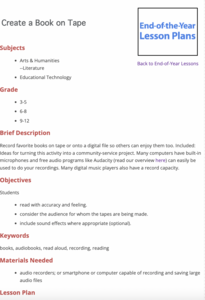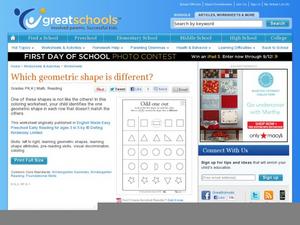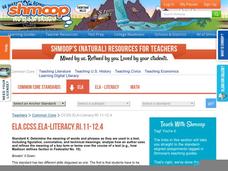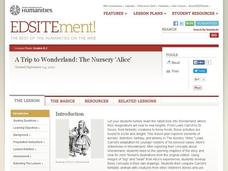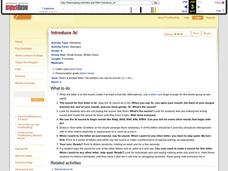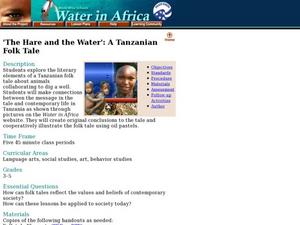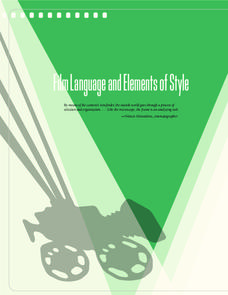Curated OER
Reading Comprehension: Context Clues
Fifth graders use context clues to help them understand unknown words. In this context clues lesson, 5th graders practice identifying context clues on a worksheet, then work with a peer to write their own story. Stories are peer edited...
Curated OER
Picture Sentences --All About School
For this reading comprehension/visualization worksheet, students study 5 pictures. From a list of 4 sentences, students match the appropriate sentence to the picture.
Curated OER
Center for Northwestern Art: Featured Objects
Each of the slides in this presentation provide learners with an image found at a northwestern art museum and a critical analysis of what can be seen in each piece. Learners can view this prior to a museum trip in order to build...
Curated OER
Match the Birds
Dive into pre-reading using this matching worksheet which focuses on the word same. Youngsters draw lines connecting the birds that are the same, coloring in the images. There are four pairs here. Consider incorporating bird names...
Curated OER
Vocabulary
Fourth graders classify vocabulary words by category. Through matching and classification activities, 4th graders sort words pertaining to trees and forest habitats into appropriate categories. They discuss how vocabulary practice can...
Curated OER
Using Context Clues
Teach your third graders how to find the meanings of words using context clues. Using this reading lesson, discuss how readers can find the meaning of a word by using the sentences around it. They then complete a worksheet in which they...
Curated OER
Fire! Fire! Fire!
The book Play Ball, Amelia Bedelia, is read with quickness and fluency in this instructional activity. The teacher models slow, choppy oral reading, and then smooth, quick, and fluent oral reading. Then, students read orally with a...
Curated OER
We Love to Read Bulletin Board
Young artists create a bulletin board based on books they have read. They complete a book report and share the information with the class, and use different types of technology to help finish the board.
Curated OER
Create a Book on Tape
Learners of all ages record themselves reading their favorite books with accuracy and feeling. They must read with sound effects and consider the audience for whom the tape is being made. They are assessed based on the quality of their...
Curated OER
Which Geometric Shape is Different?
What is the difference between a star and a triangle? Its attributes of course. Discuss the basic shapes with your class, then have them practice identifying shapes by circling the one in each row that is different.
Curated OER
Using Harmonic Vision’s Music Ace Software to Reinforce Basic Music Skills
If you have access to Harmonic Vision’s Music Ace Software, then this lesson could work for you. Kindergarteners use the video music software to place, identify, and read musical notes. They listen in and identify both high and low...
Curated OER
SOS Titanic by Eve Bunting
For this literature worksheet, learners read the novel SOS Titanic by Eve Bunting and then answer ten comprehension questions about the novel.
Curated OER
Brog-Cube-the Spam
A Middle school special ed class uses the acronym SPAM to learn the 4 parts of writing. They employ 4 different colors to help them visually distinguish each part of writing in a given prompt. This lesson plan is vague and uses a strong...
Curated OER
Ordinary People: Guided Imagery
After reading chapter six of Ordinary People with your class, conduct this activity with your class. Turn the lights down, put on your softest voice, and have them try to imagine that they lost a close friend. Then, encourage them to...
Shmoop
ELA.CCSS.ELA-Literacy.RI.11-12.4
Determining the meaning of a word based on context clues or marking how the meaning of a term evolves in the course of a document can be a challenge in more complex text. Give your pupils an opportunity to practice this skill with a...
Curated OER
Find the Letters
Help beginning readers recognize that whole words are made up of individual letters. They examine a set of lowercase letters and circle the ones they find in a CVC word. Learners do this for the words bin and cup.
Curated OER
A Trip to Wonderland: The Nursery "Alice"
Primary learners explore elements of wonder in The Nursery "Alice" by Lewis Carroll. They analyze the plot point after listening to the text. Next, they describe the imagery in various works of children's literature using the given links...
abcteach
Music Note Cards
Help young musicians stay on beat with this series of classroom displays. Showing the name and symbol for different musical notes, these tools are a handy resource for any elementary or middle school music teacher.
Curated OER
Introduce /k/
Explore the ins and outs of the letter k using these strategies combining pronunciation, letter recognition, and initial phoneme examples. Scholars examine the letter shape and listen to you pronounce the /k/ sound. Use these tips to...
Curated OER
Graphic Scores
You can write some music scores using images rather than musical notation. Kids learn how they can become musical composers by using graphics or images in place of musical notation. An interesting slide-show, but a more interesting...
Curated OER
The Hare and the Water: A Tanzanian Folk Tale
"The Hare and the Water," a Tanzanian folk tale, lends a global perspective to literary analysis. Learners spend the first two days reading and storyboarding. On day three, they examine folk tale elements (worksheet included), and design...
Film Foundation
Film Language and Elements of Style
How do you read a frame? How do you read a shot? Here's a resource that shows viewers how to read films. As part of the study, class members examine the camera angles, lighting, movement, and cinematic point of view in Mr. Smith Goes to...
Curated OER
Papyrus to PDA
What a great project. Graphic arts young scholars consider the social, political, and economic impact made by a chosen invention. They build an argument to substantiate their reasons for choosing said invention. They create an oral...
Curated OER
Everyone Can Write Poetry
Embark on a journey of writing several different types of poetry. Fifth graders read several examples, and use the examples to model their own writing. Each poem is to be accompanied by a different art visual representation. In the end,...








